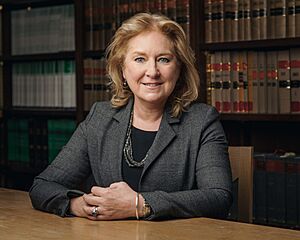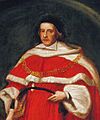Lord Chief Justice of England and Wales facts for kids
Quick facts for kids Lady Chief Justice of England and Wales |
|
|---|---|

The Judiciary of England and Wales
|
|
| Style | The Right Honourable |
| Nominator | Judicial Appointments Commission |
| Appointer | Monarch of the United Kingdom, on the recommendation of the Prime Minister and Lord Chancellor |
| Formation | 29 November 1880 |
The Lady Chief Justice of England and Wales is a very important judge. This person is the head of all judges and courts in England and Wales. If the person holding the job is male, the title is Lord Chief Justice.
Before 2005, the Lord Chief Justice was the second most senior judge. The Lord Chancellor was the most senior. But a new law in 2005 changed things. This law made the Lord Chief Justice the top judge. It also created a new role, the President of the Supreme Court. The Lord Chancellor's job became more about government, not judging.
The Lady Chief Justice often leads the part of the Court of Appeal that handles criminal cases. They are also in charge of how criminal justice works. However, the 2005 law allows them to choose another judge for these tasks.
Other parts of the UK have similar roles. In Scotland, it's the Lord President of the Court of Session. In Northern Ireland, it's the Lord Chief Justice of Northern Ireland.
Currently, Sue Carr, Baroness Carr of Walton-on-the-Hill is the Lady Chief Justice. She started in October 2023. She is the first woman to hold this important position.
Contents
Understanding the Role of the Lady Chief Justice
What Does the Lady Chief Justice Do?
The Lady Chief Justice has many important jobs. They are responsible for about 400 different duties listed in the Constitutional Reform Act 2005.
They hear important cases in criminal, civil, and family law. This includes cases that are being appealed. They also have many administrative tasks.
As the leader of the courts in England and Wales, they speak for all the judges to the government. They also look after the welfare and training of judges. They help decide which judges handle which cases.
Working with the Lord Chancellor, they handle complaints against judges. They also lead the Sentencing Council. This group helps decide how punishments are given out. They also chair the Judicial Executive Board and the Judges' Council. These groups help manage the judiciary.
A Brief History of the Chief Justice Role
How the Role Began
Long ago, there were three main courts in England. Each court had its own chief judge. These were the King's Bench, the Common Pleas, and the Exchequer. The King's Bench court started in 1234. The first chief justice for this court was appointed in 1268.
Over time, people started calling the chief justice of the King's Bench the "lord chief justice." This informal name became the official title in 1875.
Merging the Courts
In 1875, the three main courts became parts of one larger court called the High Court. The heads of these courts stayed in their jobs.
Then, in 1880, the three parts merged into a single division. Lord Coleridge, who was the last Chief Justice of Common Pleas, became the first Lord Chief Justice of England.
Adding "and Wales" to the Title
The title "and Wales" was added later. This happened when Lord Bingham of Cornhill held the office. He was the Lord Chief Justice from 1996 to 2000. He added "and Wales" to show that the role covered both England and Wales.
The Constitutional Reform Act of 2005
The Constitutional Reform Act 2005 was a big change. It gave the Lord Chief Justice many powers that the Lord Chancellor used to have. This law made the Lord Chief Justice the president of all the courts in England and Wales.
The Act also changed some specific roles. For example, the Lord Chief Justice still leads the Criminal Division of the Court of Appeal. But the role of leading the King's Bench Division became a separate job. The first person to hold the changed chief justice role was Lord Phillips of Worth Matravers.
This law also set up how the chief justice is chosen. A special committee, part of the Judicial Appointments Commission, now selects the person for the job.
The First Lady Chief Justice
In 2023, it was announced that Dame Sue Carr would be the next Chief Justice. People wondered if the title would change from "Lord" to "Lady." This had already happened in Northern Ireland with Dame Siobhan Keegan.
On September 27, 2023, it was confirmed that Dame Sue Carr chose the title "Lady Chief Justice." When she officially started on October 1, 2023, she became the first Lady Chief Justice in the role's long history. This was a significant moment!
Images for kids
See also
- Master of the Rolls






















































